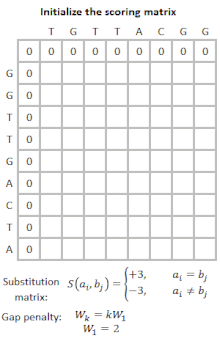|
FASTA
FASTA is a DNA and protein sequence alignment software package first described by David J. Lipman and William R. Pearson in 1985.[1] Its legacy is the FASTA format which is now ubiquitous in bioinformatics. HistoryThe original FASTA program was designed for protein sequence similarity searching. Because of the exponentially expanding genetic information and the limited speed and memory of computers in the 1980s heuristic methods were introduced aligning a query sequence to entire data-bases. FASTA, published in 1987, added the ability to do DNA:DNA searches, translated protein:DNA searches, and also provided a more sophisticated shuffling program for evaluating statistical significance.[2] There are several programs in this package that allow the alignment of protein sequences and DNA sequences. Nowadays, increased computer performance makes it possible to perform searches for local alignment detection in a database using the Smith–Waterman algorithm. FASTA is pronounced "fast A", and stands for "FAST-All", because it works with any alphabet, an extension of the original "FAST-P" (protein) and "FAST-N" (nucleotide) alignment tools.  UsesThe current FASTA package contains programs for protein:protein, DNA:DNA, protein:translated DNA (with frameshifts), and ordered or unordered peptide searches. Recent versions of the FASTA package include special translated search algorithms that correctly handle frameshift errors (which six-frame-translated searches do not handle very well) when comparing nucleotide to protein sequence data. In addition to rapid heuristic search methods, the FASTA package provides SSEARCH, an implementation of the optimal Smith–Waterman algorithm. A major focus of the package is the calculation of accurate similarity statistics, so that biologists can judge whether an alignment is likely to have occurred by chance, or whether it can be used to infer homology. The FASTA package is available from the University of Virginia[3] and the European Bioinformatics Institute.[4] The FASTA file format used as input for this software is now largely used by other sequence database search tools (such as BLAST) and sequence alignment programs (Clustal, T-Coffee, etc.). Search methodFASTA takes a given nucleotide or amino acid sequence and searches a corresponding sequence database by using local sequence alignment to find matches of similar database sequences. The FASTA program follows a largely heuristic method which contributes to the high speed of its execution. It initially observes the pattern of word hits, word-to-word matches of a given length, and marks potential matches before performing a more time-consuming optimized search using a Smith–Waterman type of algorithm. The size taken for a word, given by the parameter kmer, controls the sensitivity and speed of the program. Increasing the k-mer value decreases number of background hits that are found. From the word hits that are returned the program looks for segments that contain a cluster of nearby hits. It then investigates these segments for a possible match. There are some differences between fastn and fastp relating to the type of sequences used but both use four steps and calculate three scores to describe and format the sequence similarity results. These are:
FASTA can remove complexity regions before aligning the sequences by encoding low complexity regions in lower case and using the -S option. However, the BLAST program offers more options for correcting for biased composition statistics. Therefore, the program PRSS is added in the FASTA distribution package. PRSS shuffles the matching sequences in the database either on the one-letter level or it shuffles short segments which length the user can determine. The shuffled sequences are now aligned again and if the score is still higher than expected this is caused by the low complexity regions being mixed up still mapping to the query. By the amount of the score the shuffled sequences still attain PRSS now can predict the significance of the score of the original sequences. The higher the score of the shuffled sequences the less significant the matches found between original database and query sequence.[5] The FASTA programs find regions of local or global similarity between Protein or DNA sequences, either by searching Protein or DNA databases, or by identifying local duplications within a sequence. Other programs provide information on the statistical significance of an alignment. Like BLAST, FASTA can be used to infer functional and evolutionary relationships between sequences as well as help identify members of gene families. See alsoReferences
|
Portal di Ensiklopedia Dunia
